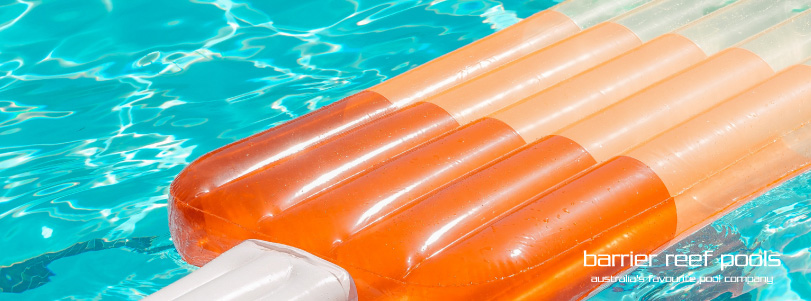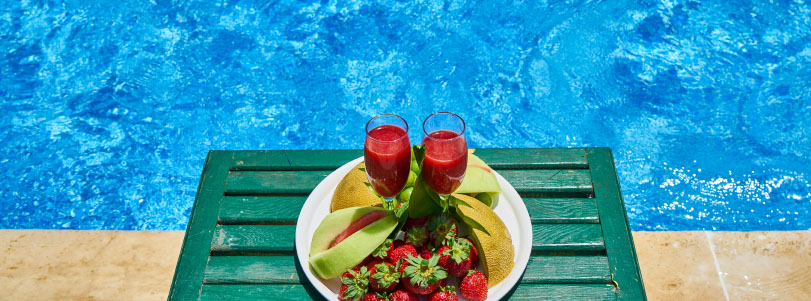5 Unique Pool Shapes And Designs
Some pool shapes, such as rectangular, round, and oval, are incredibly common and popular. However, if you're one of those homeowners who want their swimming pool to be unique, you'd ideally want to steer clear of the most common shapes. If you want to know the options you can explore in terms of unique pool shapes and designs, you're at the right place.

1. The Figure-8
If you get your swimming pool constructed in the shape of the number 8, then you’ll have a figure-8 pool. This pool shape features circular or round shapes at the ends, while the middle portion is narrow. You may also go for squared edges at the ends if you want your pool to achieve an hourglass-like appearance.
While this shape will make your pool look undoubtedly stunning, it’ll also provide you with a major practical benefit. In rectangular pools, water circulation is often affected due to water refracting backwards after it hits the pool walls. However, in figure-8 shaped pools, this isn’t an issue, and if good water circulation is your priority, you should definitely consider this shape.
However, there’s a downside to this pool shape as well, and it has to do with the construction costs. As figure-8 shaped pools tend to be more intricately detailed than rectangular pools, they can be more expensive to build, however you can consult your local pool builder on this. You’ll likely need to spend more on materials as well as on labour.
2. Freeform
In recent years, the popularity of freeform pools among homeowners has exploded, and for good reason. More and more homeowners want their swimming pools to look organic these days, and no established shape can help a swimming pool achieve this.
If you want your swimming pool to primarily be a place for your family and guests to lounge and relax, a freeform pool can work wonders. It’s also a great way to ensure that your pool can accommodate multiple people across different areas – perfect for those pool parties!
However, you’ve also got to take into account certain disadvantages that freeform pools have. For starters, if your priority is swimming, you should steer clear of a freeform pool as its contours are impractical for swimming purposes. Also, if your yard is on the smaller side, you might find it difficult to accommodate a freeform pool. Instead of opting for a small freeform pool, it would be better for you to go with a conventional rectangular or round shape.

3. L-shaped
If you have a modern home with straight edges, an L-shaped pool would work wonders in terms of it. Typically, the L’s vertical shank is on the shorter side. It also features minimal width. However, the horizontal shank offers more length and breadth. Of course, if you’d prefer an L-shaped pool, you can customize the design based on the space you have available in your yard.
L-shaped pools have several pros to offer. The most impressive thing about L-shaped pools is their appearance. Quite simply, if you want a clean look, there’s no shape better than this. Also, L-shaped pools offer multiple spaces for relaxing, which makes them suitable for pool party settings. Last but not least, because of their straight-line design, they’re good for swimming as well.
The only major downside of L-shaped pools is the fact that their elaborate design may require spending a lot of money on both materials and labour. Also, if your home isn’t modern, you’d be better off considering other pool shapes. Typically, L-shaped pools don’t work with slightly older homes.
4. Kidney
Kidney-shaped pools look similar to kidney beans. They tend to be round with an inward curve on one side. The biggest advantage of kidney-shaped pools is that they can easily fit into most modern spaces, irrespective of the available space.
If you’re planning to invest in features such as grottos, spas, and waterfalls – there’s no shape better suited for the additions. Also, due to the inward curve, you can accommodate a variety of landscaping features without any issue. So, if you’re going for a kidney-shaped pool, feel free to be creative and add as many decorative elements as you want.
On the disadvantage front, kidney-shaped pools can’t be excessively big, as that simply looks odd. Also, the detail requirements of a kidney-shaped pool are much more than conventional straight-line pools, which are bound to translate to increased material and labour costs.

5. Roman
Roman-shaped pools are nearly identical to rectangular pools. Their only difference with the latter is how the ends are designed. Typically, if you make an outward curve on one end of a rectangular pool, it will become a Roman-shaped pool. And if you do the same thing at both ends, it becomes a double Roman pool.
You can expect plenty of advantages from a pool designed in the Roman style. For starters, the major part of the pool would feature a straight-line design, which would make it ideal for swimming. However, the outward curve(s) will allow for lounging and relaxing as well. For instance, if you get tired after a draining swimming session, you can simply take a breather by sitting inside the curve. The curve also allows the addition of water features like spas and fountains.
However, if you have a small yard, you’ll probably be better off considering another pool design. Quite simply, a Roman-shaped pool works only in bigger yards, and if the pool is too small, it’ll fail to look impressive and also fail to deliver the functional benefits typically associated with Roman pools.
Conclusion
So, that’s about it for this article. We hope that we could provide enough information to you about different unique pool shapes and designs. Now, after having gone through so much information, we believe you should be able to pick the unique pool shape that’s best suited to your property and also your budget. So, go ahead, invest in the pool of your dreams, and of course, enjoy!
5 Unique Pool Shapes And Designs
Some pool shapes, such as rectangular, round, and oval, are incredibly common and popular. However, if you're one of those homeowners who want their swimming pool to be unique, you'd ideally want to steer clear of the most common shapes. If you want to know the options you can explore in terms of unique pool shapes and designs, you're at the right place.

1. The Figure-8
If you get your swimming pool constructed in the shape of the number 8, then you’ll have a figure-8 pool. This pool shape features circular or round shapes at the ends, while the middle portion is narrow. You may also go for squared edges at the ends if you want your pool to achieve an hourglass-like appearance.
While this shape will make your pool look undoubtedly stunning, it’ll also provide you with a major practical benefit. In rectangular pools, water circulation is often affected due to water refracting backwards after it hits the pool walls. However, in figure-8 shaped pools, this isn’t an issue, and if good water circulation is your priority, you should definitely consider this shape.
However, there’s a downside to this pool shape as well, and it has to do with the construction costs. As figure-8 shaped pools tend to be more intricately detailed than rectangular pools, they can be more expensive to build, however you can consult your local pool builder on this. You’ll likely need to spend more on materials as well as on labour.
2. Freeform
In recent years, the popularity of freeform pools among homeowners has exploded, and for good reason. More and more homeowners want their swimming pools to look organic these days, and no established shape can help a swimming pool achieve this.
If you want your swimming pool to primarily be a place for your family and guests to lounge and relax, a freeform pool can work wonders. It’s also a great way to ensure that your pool can accommodate multiple people across different areas – perfect for those pool parties!
However, you’ve also got to take into account certain disadvantages that freeform pools have. For starters, if your priority is swimming, you should steer clear of a freeform pool as its contours are impractical for swimming purposes. Also, if your yard is on the smaller side, you might find it difficult to accommodate a freeform pool. Instead of opting for a small freeform pool, it would be better for you to go with a conventional rectangular or round shape.

3. L-shaped
If you have a modern home with straight edges, an L-shaped pool would work wonders in terms of it. Typically, the L’s vertical shank is on the shorter side. It also features minimal width. However, the horizontal shank offers more length and breadth. Of course, if you’d prefer an L-shaped pool, you can customize the design based on the space you have available in your yard.
L-shaped pools have several pros to offer. The most impressive thing about L-shaped pools is their appearance. Quite simply, if you want a clean look, there’s no shape better than this. Also, L-shaped pools offer multiple spaces for relaxing, which makes them suitable for pool party settings. Last but not least, because of their straight-line design, they’re good for swimming as well.
The only major downside of L-shaped pools is the fact that their elaborate design may require spending a lot of money on both materials and labour. Also, if your home isn’t modern, you’d be better off considering other pool shapes. Typically, L-shaped pools don’t work with slightly older homes.
4. Kidney
Kidney-shaped pools look similar to kidney beans. They tend to be round with an inward curve on one side. The biggest advantage of kidney-shaped pools is that they can easily fit into most modern spaces, irrespective of the available space.
If you’re planning to invest in features such as grottos, spas, and waterfalls – there’s no shape better suited for the additions. Also, due to the inward curve, you can accommodate a variety of landscaping features without any issue. So, if you’re going for a kidney-shaped pool, feel free to be creative and add as many decorative elements as you want.
On the disadvantage front, kidney-shaped pools can’t be excessively big, as that simply looks odd. Also, the detail requirements of a kidney-shaped pool are much more than conventional straight-line pools, which are bound to translate to increased material and labour costs.

5. Roman
Roman-shaped pools are nearly identical to rectangular pools. Their only difference with the latter is how the ends are designed. Typically, if you make an outward curve on one end of a rectangular pool, it will become a Roman-shaped pool. And if you do the same thing at both ends, it becomes a double Roman pool.
You can expect plenty of advantages from a pool designed in the Roman style. For starters, the major part of the pool would feature a straight-line design, which would make it ideal for swimming. However, the outward curve(s) will allow for lounging and relaxing as well. For instance, if you get tired after a draining swimming session, you can simply take a breather by sitting inside the curve. The curve also allows the addition of water features like spas and fountains.
However, if you have a small yard, you’ll probably be better off considering another pool design. Quite simply, a Roman-shaped pool works only in bigger yards, and if the pool is too small, it’ll fail to look impressive and also fail to deliver the functional benefits typically associated with Roman pools.
Conclusion
So, that’s about it for this article. We hope that we could provide enough information to you about different unique pool shapes and designs. Now, after having gone through so much information, we believe you should be able to pick the unique pool shape that’s best suited to your property and also your budget. So, go ahead, invest in the pool of your dreams, and of course, enjoy!


